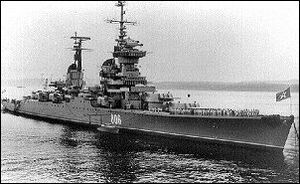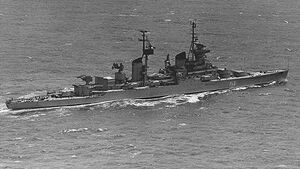Murmansk
| Murmansk | |||
|---|---|---|---|
 | |||
| Tekniske data | |||
| Lengde (m) | 210 | ||
| Bredde (m) | 22 | ||
| Dypgående (m) | 7,2 | ||
| Toppfart (knop) | 32.5 knop | ||
| Motor | Geared steam turbines delivering 110,000 hp to two propeller shafts | ||
| Tonnasje | 13600 BRT | ||
| Deplasement | 17000 (fully loaded) | ||
| Mannskap | 1250 | ||
| Karriere | |||
| Rederi | Russisk Marine | ||
| Bygget | Severodvinsk (Rus) 1953 | ||
| Dykket | |||
|
Karthjelpen:
| |||
Historie [1]
Den tidligere Sovjetiske krysseren Murmansk var i slep fra Murmansk i Russland til hugging i India i desember 1994, da slepet røk og krysseren grunnstøtte sørvest på øya Sørøya. Vraket av Murmansk ligger idag nært den lille byen Sørvær vest for Hammerfest. Det ble gjort noen halvhjertede forsøk på å fjerne vraket, men pr. dags dato ( 2007 ), befinner Murmansk seg fortsatt stående på grunt vann ved Sørvær. Mestaprten av krysseren kan fortsatt ses fra land, og kun snaue fire meter av skroget står under vann...
The Sverdlov Class cruisers, Soviet designation Project 68B, were the last conventional cruisers built for the Soviet Navy, 13 ships were completed before Nikita Khrushchev called a halt to the programme as these ships were considered obsolescent with the advent of the guided missile. They were improved and slightly enlarged versions of the Chapayev class cruiser. Murmansk -named after the city of Murmansk was launched 24 April 1955 and completed 22 eptember 1955, On her way to India for scrapping she ran aground december 1994 at Hasvik, Norway
The Sverdlov cruiser was the first of the post-war cruisers. They replaced the Chapayev class cruisers that were designed before the Second World War, but only completed at the end of the war. Unfortunately the ship was merely a modernized version of the gun armed ships of the pre war period. It did not take into account the devastating effects of air power, guided missiles, or nuclear weapons. The ship was also very costly. Still, it fit both Stalin's and Admiral Kuznetsov's ideas of a powerful surface fleet. Twenty ships of the class were planned. That all changed with Stalin's death in 1953. Nikita Khrushchev believed that it was a relic of the way wars used to be fought and would not survive in a modern naval battle. Admiral Kuznetsov fought vigorously for the project and other similar ones, but was dismissed in favor of Admiral Gorshkov who shared Khrushchev's ideas. The program faced severe cut backs. Only 17 of the ships were ever launched and of those only 14 were completed between 1951 and 1955. Many attempts to modernize these ships were attempted. In the late 1950's the Dzerzhinski was converted into an experimental anti-aircraft cruiser with twin SA-2 'Guideline' missiles in place of the X turret. This was ultimately unsuccessful and no other ships were converted in this manner. It was kept in reserve in the Black Sea until it was decommissioned. The Admiral Nakhimov was also selected around 1960 to be a test vessel for SS-N-1 'Scrubber' anti-shipping missiles. This conversion was also unsuccessful and the ship was decommissioned in 1961 without ever leaving Soviet waters. In 1962 the Ordzhonikidze was transferred to Indonesia (where it was renamed the Irian). This vessel was later scrapped in Taiwan in 1972 due to a chronic lack of spare parts to maintain the ship. In 1971 two other ships (the Admiral Senyavin and Zhadanov) were converted into command cruisers (called Korabl Upravleuiye or KU). These ships were to manage special deployments with the Pacific Fleet and the Black Sea Fleet. Three of the ships underwent refits between 1977 and 1979 (the Suverov and Oktoberskya Revolutsia being two of them). The Aleksandr Nevsky and Murmansk were allocated to the Northern Fleet; the Aleksandr Suvorov, and Dmitri Pozharsky were with the Pacific Fleet with the Admiral Lazarev in the reserve. In the Baltic Fleet two ships remain, the Oktobrskya Revolutsia and the Sverdlov (in reserve). The Black Sea fleet operates the remaining two (the Admiral Ushakov and Mikhail Kutuzov). As of 1980 there were a total of 12 Sverdlov class ships in service, but by 2000 all of these graceful ships had been withdrawn from service marking the end of the gun-only surface warship. The last to be stricken from the fleet lists was the Murmansk in 1992.
Armament:
- (Varies by ship) 4x Triple 152mm (6 in) guns*
- 6x Twin 100mm (3.9 in) Dual Purpose Guns
- 2x Quintuple 533mm (21in) Torpedo Tubes**
- 16x Twin 37mm Anti-Aircraft Guns*
- 1x Twin SA-N-4 'Gecko' SAM, with 18 missiles*
- 4x Twin 30mm AA guns*
- 200 mines can also be carried*
Sensor Suite:
- 1x 'Big Net' or 'Top Trough' air search radar
- 1x 'High Sieve' or 'Low Sieve' air search radar
- 1x 'Knife Rest' air search radar*
- 1x 'Slim Net' air search radar
- 1x 'Don-2' or 'Neptune' navigational radar
- 2x 'Sun Visor' gun fire control radars
- 2x 'Top Bow' 152mm gun fire control radars
- 8x 'Egg Cup' gun fire control radars
- 2x 'Watch Dog' ECM systems
- ( *on some ships only )
- 1x 'Top Trough' air search radar
- 1x 'Pop Group' SA-N-4 fire control radar
- 1x 'Sun Visor' 152mm (6in) gun fire control radar
- 2x 'Top Bow' 152mm (6in) gun fire control radars
- 4x 'Drum Tilt' 30mm fire control radars
- (only two in Zhadanov)
- 6x 'Egg Cup' gun fire control radars
Engine: Geared steam turbines delivering 110,000 hp to two propeller shafts. Crew: 1250 Officers and Sailors Maximum Speed: 32.5 knots NORTHERN FLEET Admiral Kuznetsov , which heads the air defense of the Barents Sea. Shore-based naval aviation included 200 combat aircraft and sixty-four helicopters. The Northern Fleet has two naval infantry brigades, one coastal defense regiment, and an air defense missile regiment. In 1989 the Soviet Navy had nearly 200 nuclear submarines in operation, while by 1996 barely half this number was in service, of which two-thirds belonged to the Northern Fleet. Principal concerns with respect to the Russian Northern Fleet are related to de-fuelling activities and laid-up submarines still containing nuclear fuel. Given the former Soviet Union's inadequate management of nuclear and chemical wastes from industrial and military activities, and the associated health and environmental risks, these efforts are critical. The case against environmentalist and former Soviet Navy Captain Aleksandr Nikitin raised questions about Russia's commitment to international standards of human rights. Nikitin was arrested in early 1996 for his role in publishing a report on the nuclear hazards posed by the decaying Russian Northern Fleet. The prosecution's case is based on secret decrees, which were issued after Nikitin's arrest and released to Nikitin and his attorney only after the trial began. Russian authorities have admitted the theft of substantial quantities of highly-enriched uranium within their own borders. A Russian naval officer on trial in Murmansk for having stolen 4 kg of 20%-enriched U235 in November 1993 has described how he simply walked straight into a poorly guarded storage area in Severomorsk (headquarters of the Russian Northern Fleet), forced a padlock on a door, and walked out with several canisters of nuclear fuel rods.
Referanser
- ↑ Orginalt fra skovheim.org
Linker
- http://www.dagbladet.no/2009/07/29/nyheter/innenriks/miljo/7416439/
- http://www.regjeringen.no/nb/dep/fkd/pressesenter/pressemeldinger/2008/vraket-av-murmansk-.html?id=524444
- http://www.aftenposten.no/nyheter/iriks/article3191584.ece
- http://www.lofotposten.no/lokale_nyheter/article3699838.ece
Kart
Karthjelpen:
- Når pekeren din er over kartet, vil scrolling endre zoom-nivå.
- Full-skjerm med symbol i øvre høyre hjørnet.
- Dobbelklikk på et område på kartet og du zoomer inn på det.
- For de kart med flere kartlag, kan du velge i øvre høyre hjørnet hvilket du vil se.
- Mer om hvordan opprette kart her.

